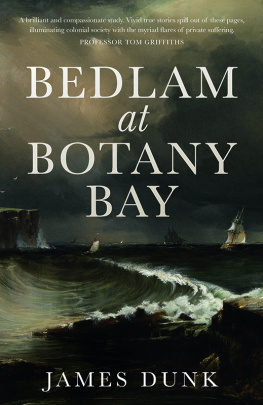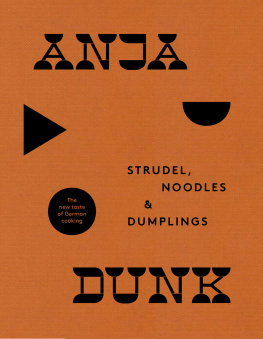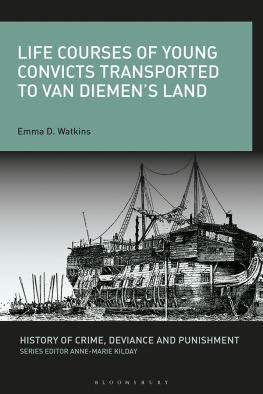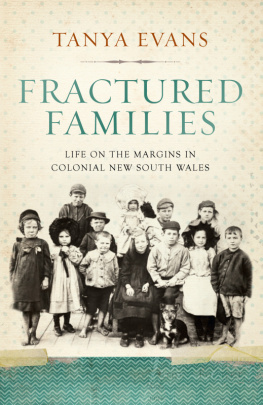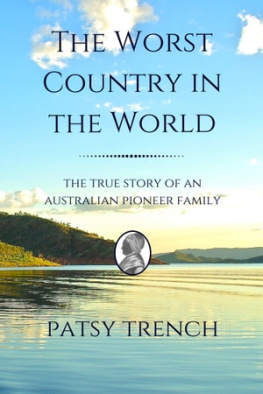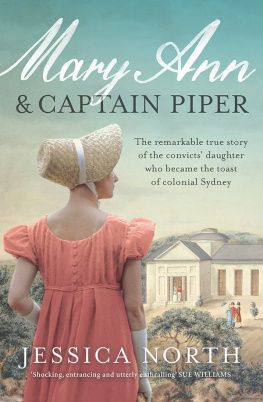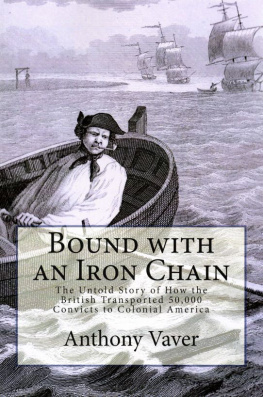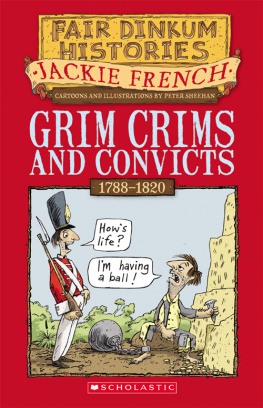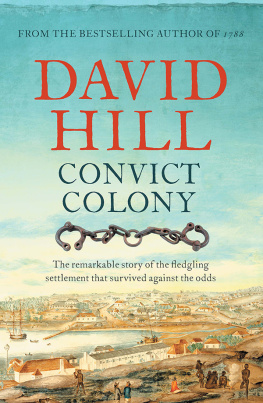
BEDLAM
at
BOTANY
BAY
JAMES DUNK is a historian and writer living and working in Sydney, on Gadigal country. A research fellow at the University of Sydney and a conjoint fellow at the University of Newcastle, James is a frequent contributor to the Australian Book Review.
BEDLAM
at
BOTANY
BAY
JAMES DUNK

A NewSouth book
Published by
NewSouth Publishing
University of New South Wales Press Ltd
University of New South Wales
Sydney NSW 2052
AUSTRALIA
newsouthpublishing.com
James Dunk 2019
First published 2019
This book is copyright. Apart from any fair dealing for the purpose of private study, research, criticism or review, as permitted under the Copyright Act, no part of this book may be reproduced by any process without written permission. Inquiries should be addressed to the publisher.

A catalogue record for this book is available from the National Library of Australia
ISBN 9781742236179 (paperback)
9781742244556 (ebook)
9781742249025 (ePDF)
Design Josephine Pajor-Markus
Cover design Luke Causby, Blue Cork
All reasonable efforts were taken to obtain permission to use copyright material reproduced in this book, but in some cases copyright could not be traced. The author welcomes information in this regard.

CONTENTS
ACKNOWLEDGMENTS
When I began at the University of Sydney I enrolled in everything from chemistry, calculus and French to literature, government, and political economy. History came upon me almost by stealth, captivating me with its interest in people not as research subjects or examples of abstractions, but as they actually live and breathe. Richard White drew me into higher research, with his mixture of irony and sympathy, and he continues to be an encouraging and astute reader. As a graduate student I benefited enormously from Sydneys superb intellectual environment, and particularly from the guidance and friendship of Nick Eckstein, Sebastin Gil-Riao, Chris Hilliard, Peter Hobbins, Miranda Johnson, Andres Rodriguez, Ricardo Roque, Penny Russell, and Ben Silverstein. Mark McKenna and Iain McCalman ran a striking seminar which left many of us passionate about the place of historical imagination in our writing. Alan Atkinson and Stephen Garton gave valuable early advice. Alison Bashford helped to establish my project and instilled a sense of the rigour and precision which history demands.
The extraordinary historian John Hirst had a powerful impact on many of us. In the seminars he hosted he insisted on the value of working word by word and line by line, trimming fat and sometimes carving down to the bone. An elder statesman of the historical community and a leading scholar on colonial Australia, to me and other young historians he was a remarkably generous patron.
This book, like all historical work in this country, is underwritten by its fine cultural institutions, including the Mitchell Library, State Library of New South Wales, New South Wales State Archives, Libraries Tasmania, and the National Library of Australia, which hosts a vast collection of digitised newspapers that is the envy of historians everywhere. The cafes of the Inner West made their own investments in this book by overlooking my table for hours and sometimes days on end, and I recall them with fond thanks: Shenkin, Ralphs, Tripod, In the Annex, Ella, Tobys Estate.
A workshop in wintry Dunedin proved formative for my historical thinking: Volker Hess, Kathryn Hunter, Rebecca Lenihan, Jane McCabe, James Moran and I explored the ways that schools, armies, hospitals and asylums left paper trails which are now guarded in archives that withhold as well as disclose. The brilliant Sally Swartz stimulated us all to think more deeply, and Barbara Brookes, who brought us all together, remains a great friend and mentor.
Many exceptional historians have contributed their energies to help usher this book into the world. Hans Pols read through large swathes of text and helped me to think more adventurously about madness and empire. Christine Winter committed many evenings to reading through the entire manuscript, in an earlier form, and helped to clarify and extend its arguments. Hamish Maxwell-Stewart offered a critical reading and his firm support. Others, including many already named, read chapters at different stages and helped to sharpen and strengthen them: Jeannine Baker, Cath Bishop, Helen Bones, Emma Gleadhill, Chris Holdridge, Shane Greentree, Tom Griffiths, Claire Higgins, Katja Heath, Meredith Lake, Greg Murrie, and Alan Rome. In recent years, the members of our early-career writing group have been perceptive and heartening readers: Michaela Cameron, James Findlay, Rohan Hewitt, James Keating, Isobelle Barrett Meyering, Briony Neilson, Danielle Thyer, and Mick Warren. Billy Griffiths, Matthew Kennedy, Hugh Chilton and Cathy Perkins have also been wonderful companions in writing and researching.
Kirsten McKenzie has been an excellent guide through these years of reading and writing about Sydney, the sea, and colonial enterprise. Her hard-headed advice has been invaluable. Her brilliant story-telling about unlikely historical protagonists, and skill in drawing them into profound arguments about empire, were sources of inspiration for this book. Catharine Coleborne has been a wise and supportive mentor in recent years. Her work on colonial asylums and their place in forming southern societies is matchless, and she is a model of grace in an academic environment that can be harried and unkind. Much of the work here was made possible by Warwick Anderson, who is not only a luminous, world-leading historian but an exceptionally generous and considered mentor. His writing, which is elegant, unsparing, and audacious, continues to shape my approach to the discipline of history.
Phillipa McGuinness, at NewSouth, saw the potential in this book well before it took shape, and contributed a good deal to its form and style. Emma Hutchinson brought the book together with great dexterity and Tricia Dearborn helped to guide it through its final stages. Parts of in Authority and the Treatment of the Insane at Castle Hill Asylum, 181125, Health and History 19, no. 2 (2017): 1740, and of Chapter 8 in Work, Paperwork and the Imaginary Tarban Creek Lunatic Asylum, 1846, Rethinking History 22, no. 3 (2018): 326355. I am grateful to the journal editors and reviewers for their suggestions.
More than many families my siblings and I stand against a storm of our own making and the making of others. This book is a testament to our surviving this far, and I hope a gift to my mother, Joy, whose kindness has proven intractable. My brother Jonathan has been a close companion for three decades. His words are beautiful and startling, and his intelligence is incandescent. And to my own small family, which bears with me and shares everything with me, I owe more than I can say to my wife Stephanie, my first reader, who has poured her intellectual, spiritual and practical support into me and into this book, and to my sons, Aubrey and Ira. Their warmth, humour, and curiosity teach me to trust in the future.
INTRODUCTION
Pitt and Botany Bay! the convicts cheered in Newgate Prison, at the news the British would create a penal colony in the half-mapped southern land. Or so quipped the London newspaper
Next page
